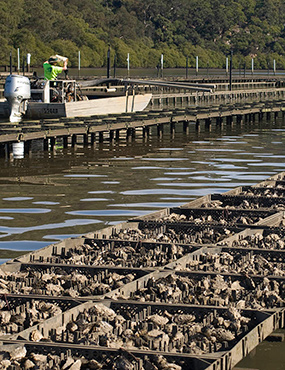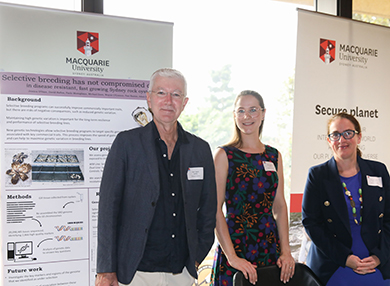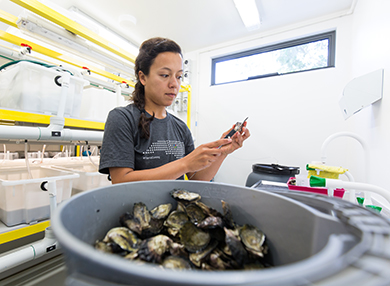Revitalising oyster production in New South Wales
In the early 2000s, NSW’s multi-million-dollar Sydney rock oyster industry was at risk of being wiped out by QX (Queensland Unknown) disease. Macquarie has helped the industry recover, diversify and grow.

Breeding disease resistant oysters
The iconic Sydney rock oyster is the mainstay of NSW’s oldest and largest aquaculture industry. When QX disease threatened the industry’s long-term viability, researchers from Macquarie’s School of Natural Sciences collaborated with oyster farmers and the NSW government to address this urgent problem.
Together, they:
- discovered when and how QX kills Sydney rock oysters
- cultivated disease resistant oyster populations
- helped build a more resilient oyster industry.
A destructive disease
QX disease is caused by a single-celled parasite (Marteilia sydneyi). Marteilia sydneyi only impacts the native Sydney Rock Oyster – the main species of oyster found and farmed along the east coast of NSW and into southern Queensland.
The first recorded outbreak of QX disease occurred in Sydney’s Georges River in 1994. This outbreak eventually forced the closure of the Sydney rock oyster industry in that estuary for several years. The Hawkesbury River was also hit by QX disease in 2004. By 2006, oyster production in that estuary was virtually non-existent.
QX similarly shut down the oyster industry in several other estuaries. Revenue shrank. Jobs were lost.
Reducing Sydney rock oyster mortality
An initial conundrum posed by QX disease was why it devastates Sydney rock oyster populations in some but not all estuaries in which Marteilia sydneyi is present.
In partnership with the NSW Department of Primary Industries (DPI), Macquarie’s biologists discovered that certain environmental stressors make the oysters vulnerable to the parasite.
 Led by Professor David Raftos, pictured here with Professor Melanie Bishop and Dr Jessica O'Hare at the Inaugural NSW Research Impact Showcase (2022), Macquarie’s team showed that low water salinity, associated with heavy rainfall, provokes a cellular response in the oysters. This response destroys key blood cells responsible for controlling Marteilia sydneyi. Subsequent research with the DPI found that high temperatures and chemical contamination have the same detrimental effect.
Led by Professor David Raftos, pictured here with Professor Melanie Bishop and Dr Jessica O'Hare at the Inaugural NSW Research Impact Showcase (2022), Macquarie’s team showed that low water salinity, associated with heavy rainfall, provokes a cellular response in the oysters. This response destroys key blood cells responsible for controlling Marteilia sydneyi. Subsequent research with the DPI found that high temperatures and chemical contamination have the same detrimental effect.
Having established when and how external stressors compromise oyster immune systems, Macquarie’s researchers worked with the DPI and oyster farmers to identify about 30 genes that help oysters withstand QX. This knowledge enabled Macquarie and the DPI to overhaul the existing selective oyster breeding program to breed for QX resistance.
This innovative program has brought much relief to the oyster industry. Within one generation (three years), Sydney rock oyster survivorship increased by 30 per cent. The industry did not collapse as was initially feared.
Diversifying for resilience
Professor Bishop, Professor Raftos and their team have made a further contribution to the long-term resilience of the NSW oyster industry. Macquarie’s strategic advice to the DPI informed decisions to diversify the industry through the widespread aquaculture of the non-native Pacific oyster.
The Pacific oyster is the world’s most cultivated oyster species. Although it has been present in NSW waters since at least the mid-1960s, the Pacific oyster was considered a noxious pest that threatened to overrun Sydney rock oyster habitats. Culturing of the Pacific oyster was prohibited in every NSW estuary except Port Stephens.
Crucially, the Pacific oyster is not affected by QX disease.
 With the onset of the QX outbreaks, Macquarie’s researchers began investigating what would happen if Pacific oyster aquaculture was expanded into NSW estuaries beyond Port Stephens. The team showed that the non-native oyster would in fact not proliferate to the extent that it would displace natural populations of the Sydney rock oyster.
With the onset of the QX outbreaks, Macquarie’s researchers began investigating what would happen if Pacific oyster aquaculture was expanded into NSW estuaries beyond Port Stephens. The team showed that the non-native oyster would in fact not proliferate to the extent that it would displace natural populations of the Sydney rock oyster.
Since 2005 the DPI has issued permits that allow oyster farmers to cultivate one type of Pacific oyster in several estuaries across NSW: the Triploid Pacific oyster. As the Triploid is bred for sterility, there is an especially low risk that culturing this type of oyster will endanger wild oyster populations.
This decision to allow the cultivation of the triploid Pacific oyster prevented the collapse of many NSW oyster businesses jeopardised by QX disease, especially those in the Hawkesbury and Georges River estuaries.
Restoring the NSW oyster industry
Between 2011 and 2021, revenue from oyster sales in NSW has grown from $38 million to $58 million. Macquarie’s contribution to the improved Sydney rock oyster breeding program and advice about industry diversification have helped oyster farmers in many estuaries get back on their feet and have laid a platform for recovery for those farmers currently struggling with QX disease.
14 Eastern Road
Macquarie University NSW 2109